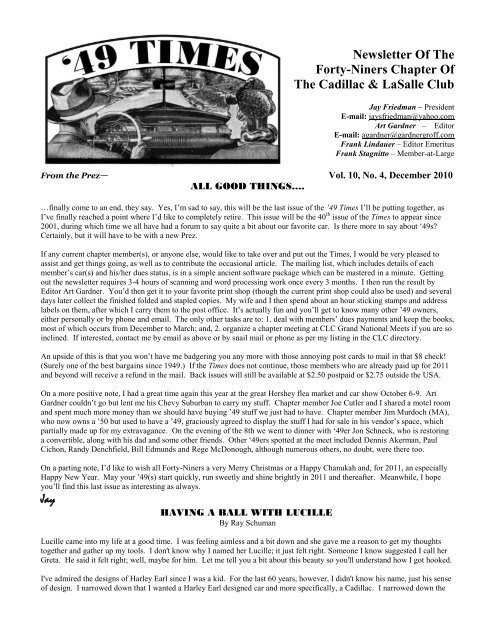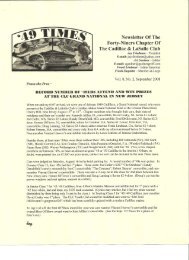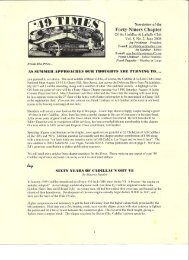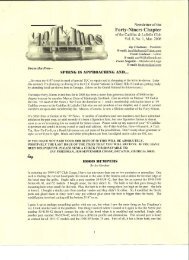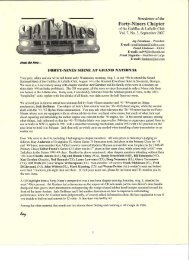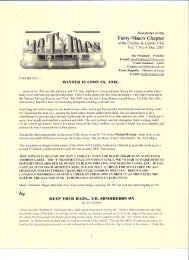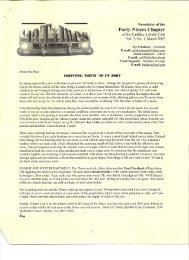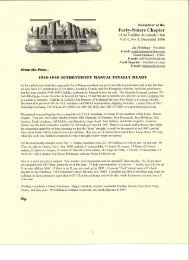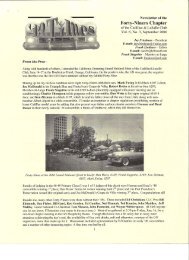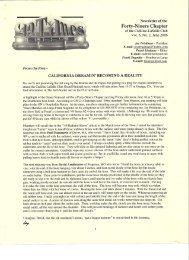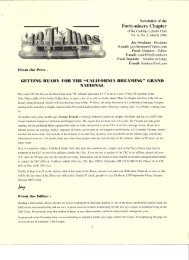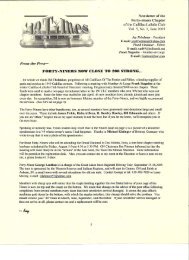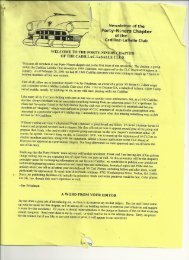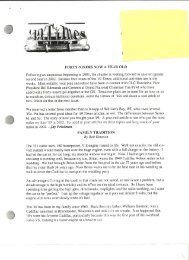Create successful ePaper yourself
Turn your PDF publications into a flip-book with our unique Google optimized e-Paper software.
Newsletter Of The<br />
Forty-Niners Chapter Of<br />
The Cadillac & LaSalle Club<br />
Jay Friedman – President<br />
E-mail: jaysfriedman@yahoo.com<br />
Art Gardner – Editor<br />
E-mail: agardner@gardnergroff.com<br />
Frank Lindauer – Editor Emeritus<br />
Frank Stagnitto – Member-at-Large<br />
From the Prez— Vol. 10, No. 4, <strong>December</strong> <strong>2010</strong><br />
ALL GOOD THINGS….<br />
…finally come to an end, they say. Yes, I‟m sad to say, this will be the last issue of the ’49 Times I‟ll be putting together, as<br />
I‟ve finally reached a point where I‟d like to completely retire. This issue will be the 40 th issue of the Times to appear since<br />
2001, during which time we all have had a forum to say quite a bit about our favorite car. Is there more to say about „49s?<br />
Certainly, but it will have to be with a new Prez.<br />
If any current chapter member(s), or anyone else, would like to take over and put out the Times, I would be very pleased to<br />
assist and get things going, as well as to contribute the occasional article. The mailing list, which includes details of each<br />
member‟s car(s) and his/her dues status, is in a simple ancient software package which can be mastered in a minute. Getting<br />
out the newsletter requires 3-4 hours of scanning and word processing work once every 3 months. I then run the result by<br />
Editor Art Gardner. You‟d then get it to your favorite print shop (though the current print shop could also be used) and several<br />
days later collect the finished folded and stapled copies. My wife and I then spend about an hour sticking stamps and address<br />
labels on them, after which I carry them to the post office. It‟s actually fun and you‟ll get to know many other ‟49 owners,<br />
either personally or by phone and email. The only other tasks are to: 1. deal with members‟ dues payments and keep the books,<br />
most of which occurs from <strong>December</strong> to March; and, 2. organize a chapter meeting at CLC Grand National Meets if you are so<br />
inclined. If interested, contact me by email as above or by snail mail or phone as per my listing in the CLC directory.<br />
An upside of this is that you won‟t have me badgering you any more with those annoying post cards to mail in that $8 check!<br />
(Surely one of the best bargains since 1949.) If the Times does not continue, those members who are already paid up for 2011<br />
and beyond will receive a refund in the mail. Back issues will still be available at $2.50 postpaid or $2.75 outside the USA.<br />
On a more positive note, I had a great time again this year at the great Hershey flea market and car show October 6-9. Art<br />
Gardner couldn‟t go but lent me his Chevy Suburban to carry my stuff. Chapter member Joe Cutler and I shared a motel room<br />
and spent much more money than we should have buying ‟49 stuff we just had to have. Chapter member Jim Murdoch (MA),<br />
who now owns a ‟50 but used to have a ‟49, graciously agreed to display the stuff I had for sale in his vendor‟s space, which<br />
partially made up for my extravagance. On the evening of the 8th we went to dinner with „49er Jon Schneck, who is restoring<br />
a convertible, along with his dad and some other friends. Other „49ers spotted at the meet included Dennis Akerman, Paul<br />
Cichon, Randy Denchfield, Bill Edmunds and Rege McDonough, although numerous others, no doubt, were there too.<br />
On a parting note, I‟d like to wish all Forty-Niners a very Merry Christmas or a Happy Chanukah and, for 2011, an especially<br />
Happy New Year. May your ‟49(s) start quickly, run sweetly and shine brightly in 2011 and thereafter. Meanwhile, I hope<br />
you‟ll find this last issue as interesting as always.<br />
Jay<br />
HAVING A BALL WITH LUCILLE<br />
By Ray Schuman<br />
Lucille came into my life at a good time. I was feeling aimless and a bit down and she gave me a reason to get my thoughts<br />
together and gather up my tools. I don't know why I named her Lucille; it just felt right. Someone I know suggested I call her<br />
Greta. He said it felt right; well, maybe for him. Let me tell you a bit about this beauty so you'll understand how I got hooked.<br />
I've admired the designs of Harley Earl since I was a kid. For the last 60 years, however, I didn't know his name, just his sense<br />
of design. I narrowed down that I wanted a Harley Earl designed car and more specifically, a Cadillac. I narrowed down the
years to about 1948 or 1949. The design and mechanics of those years to me were special to me. I chose 1949 since that was<br />
the year that the new V8 engine replaced the old flathead design. It introduced greater efficiency and horsepower while<br />
reducing the weight and size of the engine.<br />
I Googled “1949 Cadillac” and one of the available choices mentioned that it was in Scarsdale, New York, a Westchester<br />
County suburb of New York City not far from my home in Patterson, NY. When the picture opened, I saw this beautiful dark<br />
green Cadillac parked on the streets of Scarsdale. The shape, design, color of the Series 62, 4 door sedan all but swept me off<br />
my feet. Oddly enough, it had a special New York license plate that said 'HYDRMTIC'. I found that unusual. Why would<br />
anyone advertise that their car had an automatic transmission? To each his own. As days passed, I returned to that page<br />
repeatedly. I found that the car had been one of those participating in the Scarsdale Concours d'Elégance back in 2005. Well,<br />
we all have dreams and this was mine.<br />
As I got more serious about actually buying an old car, I saw an ad in Hemmings Motor News offering a 1949 Caddy in that<br />
same nearby Westchester County. Well, that was close enough to be able to check out a car before buying. Previously, I had<br />
put in a winning bid on Ebay for a 1949 Caddy in Maine. The reserve was not met and I didn't get that car, although the seller<br />
later contacted me about making a deal. As we exchanged emails, more and more faults of the car came out and I backed away<br />
from any deal. Now, looking back at that car, I was lucky not to get it.<br />
I contacted the seller of my Hemmings' Westchester County car who answered many questions and agreed to send pictures.<br />
When I opened the pictures on my computer, I saw that the car‟s license plate read, “HYDRMTIC”. Wow! I had stumbled<br />
across my dream car. Fortunately, the price was excellent and I just agreed to it. The seller was a financial advisor with an<br />
impressive large, old home. He had bought this car 10 years ago at an auction at Lyndhurst Castle in Irvington, NY conducted<br />
by Christie's Auction House. He showed me the published Christie's booklet showing all the cars entered in this auction,<br />
including this beauty. Wow, this car was being sold with other fantastic cars whose values were estimated up to $750,000 by<br />
Christie's. While this car's value was a mere fraction of the value of the others, I felt it was sitting in good company.<br />
The seller said that his interest in the car had slowly diminished and he wanted something newer. He provided great paperwork<br />
with the car, including the actual California license plate on the car when he got it, a copy of the owners' manual, shop manual,<br />
original 'build sheet', data sheet, accessories brochure, loads of General Motors paper and some spare parts for the car. Time to<br />
clear out the garage!<br />
I wound up completing the purchase and received the Christie's booklet and the actual auction paddle used by the seller ten<br />
years ago. He also supplied ten years of receipts for repairs and purchases for this car. From the information on the<br />
paperwork, it was easy to see that he had put about 2,000 miles on the car in ten years (that's an average of only 4 miles per<br />
week!). The car's finish isn't perfect and it needs some mechanical attention; however, I'm in love with Lucille and hope to<br />
show it off when gathering with my fellow members of the Cadillac-LaSalle and Lambda Car Clubs.<br />
RAY AND HIS 6269, “LUCILLE”, AT THE <strong>2010</strong> SCARSDALE NY CONCOURS D’ÉLÉGANCE
AN INTERESTING FORTY-NINE FACTORY PHOTO<br />
By Jay Friedman<br />
This factory photo, probably taken at Cadillac‟s Clark Street plant in Detroit, shows 3 workers lowering a ‟49 overhead valve<br />
engine into a car‟s chassis. After studying the picture a bit, there are several interesting factoids that can be gleaned from it.<br />
Art Gardner points out that the installation does not appear to be taking place on an assembly line; it looks more like a small<br />
side room since there are non-Cadillac cars in the background (of which the first is a Chevrolet or Pontiac station wagon while<br />
behind it appears to be a ‟46 or ‟47 Buick). Obviously, the three men are posing for the photographer. The guys doing the<br />
work seem to be the two men at the left and right, as they are wearing shop clothes and have their hands on the chain hoist and<br />
engine as they maneuver it into position. The guy in the middle must be a supervisor, as he has on a white shirt and seems to<br />
be motioning the guy on the left working the hoist to lower the engine v e r y s l o w l y and carefully so it won‟t bang into<br />
anything. The job of the guy at the right must be to push and pull on the motor to doubly make sure of just that, as well as to<br />
ensure that the downward facing motor mount bolts go straight into their holes on the frame.<br />
It's an early 1949 Cadillac engine, as there are 2 bolts at the top holding on the valve cover instead of the 4 bolts around the<br />
perimeter of the valve cover used later in the year. Also, the spark plug wires are enclosed in a flat enclosed conduit bolted to<br />
the valve cover, rather than the open metal loops used later in the year. In addition, compare the color of the paint on the letters<br />
and 3 lines at the forward end of the valve cover to the supervisor‟s shirt: it is somewhat darker. This leads me to believe the<br />
paint on the valve cover lettering is the silvery gray used on very early cars rather than the white paint used the rest of the year.<br />
Looking at the chassis, several tidbits of info emerge. The first is that there is a '48 horn ring on the steering wheel, a further<br />
indication that this is a very early '49 Cadillac. The '48 and '49 steering wheels are the same, but the '48 horn ring is a 180<br />
degree half-circle around the lower half of the wheel like the horn ring in the photo, while the '49 horn ring is a 360 degree full<br />
circle. The next thing you‟ll notice is that under the left elbow of the man at the right is a clutch pedal. Also, you can just<br />
make out under his left hand that there are two shift levers coming out of the steering column rather than the single lever used<br />
with Hydra-matic, so this car has a manual transmission. This is noteworthy in that less than 4% of '49s were so built.<br />
Art thinks that “perhaps this was a test engine that was run on a test stand for a while and then installed in a 48 chassis for<br />
some final testing before production began for 49. For example, the exhaust manifolds look "seasoned", meaning the engine is<br />
not completely new. All this may mean that the photo was taken sometime in 1948.
WHAT A WAY TO GO!<br />
PAUL CICHON’S FANCY ’49 FUNERAL CAR, MORTICIA, STILL IN USE IN HAMPTON, CONNECTICUT<br />
MORE ON HOOKING UP HEATER HOSES<br />
Chapter member Daniel Parker of Palmdale, California sent in the diagram below and wrote that he thought it “might help the<br />
next time someone asks how to route heater hoses”. To aid in using Daniel‟s diagram, members may want to refer to the June<br />
‟09 issue of the Times, in which there appeared an article describing in text the routing of these hoses.<br />
1949 CADILLAC HEATER HOSE ROUTING<br />
`
DAVID COSKY OF HADDON HEIGHTS NJ WITH HIS 6169 AT THE ’08 CLC GRAND NATIONAL<br />
A BETTER WAY TO REMOVE YOUR STEERING WHEEL<br />
By Art Gardner<br />
If, like lots of us, you don‟t have a steering wheel puller, I‟ve come up with another, if not better, way to remove your steering<br />
wheel. Besides doing away with the need for a puller, this method spares the horn button contact from possible damage.<br />
Refer to the drawing below, which shows the top of the steering wheel after the horn button is removed. First, remove the<br />
large nut which holds the wheel. Using a small diameter round file (no, not the trash can), file “half-moon” slots into the<br />
middle of two opposite sides of the nut to line up with the threaded holes in the hub of the steering wheel.<br />
Now, refer to the drawing on the next page. Go to a hardware store or other supplier of fasteners which sells 3/8-16 “washerhead”<br />
bolts, sometimes referred to as washer-head screws. (These are bolts or screws with an integral built-in washer as part of<br />
the bolt head.) I suggest that you buy 6 such bolts: 3 pairs or 2 each, in lengths of ¾ inch, 7/8 inch and 1 inch (1.9, 2.2 and 2.5<br />
cm.), if available. You can see two of them in the drawing.
As shown in the drawing below, loosely screw on the large steering wheel hold-down nut the until most or all of its threads<br />
have engaged the steering shaft, but with some space still remaining between the bottom of the nut and the steering wheel hub.<br />
At the same time, make sure the two “half-moon” slots are lined up with the threaded holes in the steering wheel hub. Then,<br />
starting with the 1 inch pair, screw two of the washer-head bolts past the “half-moon” slots and into the threaded holes in the<br />
steering wheel hub until the washer heads are snug against the large steering wheel nut.<br />
Now, using a wrench, slowly and carefully tighten the washer-head bolts, each one a fraction of a turn at a time, so that neither<br />
bolt puts more pressure on the nut than the other. Advantageously, this works by putting force on the large threads of the<br />
steering column shaft, instead of on the end of the shaft (where it could damage the horn contact).<br />
As I did, you may find that you will have to exchange the first pair of washer-head bolts for a shorter pair as the steering wheel<br />
is pulled up. You may also find that you‟ll have to unscrew the large steering wheel nut one or more turns to create more space<br />
between it and the steering wheel hub. When the steering wheel breaks loose, you may or may not hear a snapping or popping<br />
noise. Like the 3 guys lowering the engine in the factory photo on page 3, “Easy does it”.<br />
MY 6107<br />
By Jay Friedman<br />
Since photos and descriptions of many members‟ cars have appeared in the Times over the years, I thought that as my “swan<br />
song” I would exercise my prez-idential privileges to show off my own 6107 2-door club coupe, “The Green Queen”. She‟s a<br />
“late” car, built Oct. 20, 1949 and sold by Rickenbaugh Motors in Denver. (This Cadillac dealer is still in existence and<br />
participated in the Grand National in that city in 2001.) In 1974 The Queen went from the original owner to two antique car<br />
dealers in Colorado in quick succession, one of whom replaced the original Madeira Maroon paint with a generic dark green.<br />
The second dealer sold it in 1975 to a lady in Laramie, Wyoming who, 2 years later, sold it to a collector in the Chicago area. I<br />
bought it from him via an ad in Hemmings in Sept. 1984 for $5,200. („49s were cheaper in those good old days.) It had been<br />
undercoated when new, so was practically rust-free and, though it ran well, was a bit worn cosmetically and mechanically.<br />
I had the motor rebuilt in 1985 and had it re-painted in 1986 another dark green (close to Dartmouth Green, a ‟49 color). The<br />
next year I had the original worn-out Series 61 upholstery replaced. In 1988, The Queen appeared in the opening scenes of the<br />
film “Driving Miss Daisy”, filmed in our Atlanta neighborhood. It played the role of the car of the character Boolie, Miss<br />
Daisy‟s son, who was played by Dan Akroyd. In one scene Mr. Akroyd drove the car, with Morgan Freeman, who played the<br />
character Hoke, as his passenger. If there was such a thing, it surely would have received an Academy Award as “Best Car”.<br />
Originally equipped with Hydra-matic, shortly after I bought the Queen I had stick shift installed with a correct 3.77 ratio<br />
differential for that transmission. As she‟ll cruise at interstate speeds like a ‟49 should, I drive her quite a bit, including 13 trips<br />
to CLC Grand Nationals and 3 National Driving Tours as far away from my Georgia home as Maine and Texas. I took the
photo below at the ‟08 CLC Grand National in New Jersey, following which my wife Elaine and I drove to Manhattan where<br />
we left her in a lock-up garage on 42 nd Street and then went out “on the town”.<br />
The Queen is in excellent “driver” condition and totally stock except for a cheap Radio Shack under-dash AM/FM radio which<br />
plays through the original rear speaker. The vacuum antenna works (when it is in the mood) via a valve from an early „40s<br />
Cadillac that I hooked up. To enhance the look of the interior (in my humble opinion), I bought from chapter member Dennis<br />
Akerman a NOS “standard” steering wheel which is brown in color and of simple construction, unlike the fancy deluxe ivorycolored<br />
or black wheels found on most „49s. Dennis also sold me a NOS radio delete plate which hides the dash holes where<br />
the original radio mounted. Installing goodies like these, along with routine maintenance and occasional major repairs, is<br />
enough to keep me busy in retirement. I do much of the work in my garage-workshop, but occasionally need the help of my<br />
friends John Wright, a professional restorer, and Times editor Art Gardner for tasks requiring greater skills than my own.<br />
JAY’S MODEL 6107 CLUB COUPE AT THE 2008 CLC GRAND NATIONAL, CHERRY HILL NJ<br />
CLOSE-UP VIEW OF ORIGINAL DASH WOOD-GRAINING<br />
Photo By Jeff Maltby, Patterson, California


